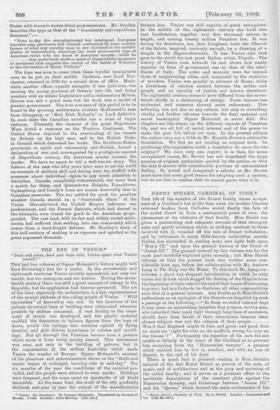THE END OF VENICE.* "Dust and ashes, dead and done
with, Venice spent what Venice earned "
THE last two volumes of Signor Molnienti's history might well have Browning's line for a motto. In the seventeenth and eighteenth centuries Venice lavishly squandered, not only her wealth, but her enterprise and her honour. During the seven- teenth century there was still a great amount of energy in the Republic, but its application had become perverted. The art of the time, especially the architecture, is a fair representation of the mental attitude of the ruling people of Venice. " Wild enormities" of decoration ran riot. In the interiors of the palaces structural lines of building were obliterated wherever possible by endless ornament. A vast facility in the treat- ment of stucco was developed, and the plastic material enabled the decorators to balance figures from the tops of doors, mould the ceilings into curtains upheld by flying amorini, and give riotous luxuriance to volutes and mould- ' ings. But all through the Venetian barocco runs a passion which saves it from being merely absurd. This vehemence was seen, not only in the building of palaces, but in the organisation of the endless festivities which. made Venice the wonder of Europe. Signor Molmenti's account of the pleasures and entertainments shows us the "Balls and masks begun at midnight, burning ever to mid-day?' For six months of the year the conditions of the carnival pre- vailed, and the people were allowed to wear masks. Holidays were frequent, and the sums spent on spectacles of all kinds incredible. At the same time, the trade of the city gradually declined, and year by year the output of the manufactories • Venice the Decadence, By rompeo Molmenti. Translated by Horatio F. Brown. 2 vols. London ; John Murray. [215. meta became less. Venice was still capable of great enterprises. In the middle of the eighteenth century she built two vast breakwaters, together over five thousand metres in length, and costing twenty million Venetian lire. It was during the decadence, too, that Longhena built the Church of the Salute, inspired, curiously enough, was a drawing of a temple in the Hypnerotomachia. It was Venice also that gave to the world the lust great Italian artist, Tiepolo. The history of Venice even towards its end shows how vastly superior its form of government was to that of the other States of Italy. The order and security were far beyond those of neighbouring cities, and, compared by the statistics of murders, Venice was greatly in advance of Rome, while a kindliness of relation existed between the nobles and people, and an equality of justice, not known elsewhere. The eighteenth century seems to have differed from the seven- teenth chiefly iu a slackening of energy. Taste became less exuberant and manners showed more refinement. This softening was not due to any reform, but only to dwindling vitality and further advance towards the final material and moral bankruptcy. Signor Molmenti is never dull. His chapters are like essays on the different aspects of Venetian life, and are all full of varied interest and of the power to make the past live before our eyes. In the present. edition the author owes not a little to Mr. Horatio Brown's admirable translation. We feel we are reading an original work. In producing this impression could a translator do more for his. original P We have only one regret ; it is that, for some unexplained reason, Mr. Brown has not translated the largo. number of original authorities quoted by the author, so that the text is strewn with considerable portions of untranslated Italian. So sound and competent a scholar as Mr. Brown must have bad some good reason for adopting such a system, but we are free to confess that we cannot guess what it is.










































 Previous page
Previous page